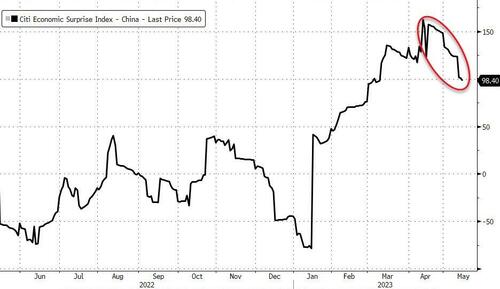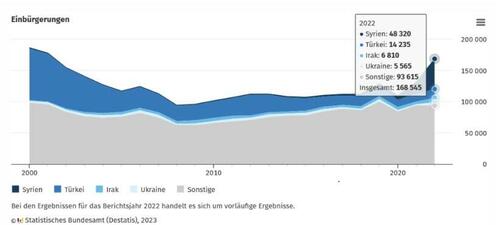Authored by Addison Graham via RealClear Wire,
Before COVID-19 raged through Chile in all its lethal power, Jorge Barrios sat in his living room using sanitation wipes to scrub a recently received package. “It’s from China,” he said. “You have to be careful with these things.”

It was February 2020, and although most Chileans had heard of COVID and its ability to kill, they –- like most of the world –- were uncertain of how the “virus from China” would spread. So the then-66-year-old Barrios scrubbed away, hoping to protect himself, his wife, and his grandchildren who lived three doors down but spent more time with their abuelos than at home.
Weeks later, the first confirmed COVID case reached Barrios’ hometown of Arica, Chile. In the months and years that followed, he would be forced to close the bakery he operated from the back of his home, he would see economic devastation take hold in his small nation, and lose over 60,000 of his countrymen.
Barrios quit scrubbing packages, but his suspicions of China only intensified.
During the pandemic, unfavorable views of China coursed throughout Latin America and much of the world as people heard reports of Chinese officials trying to cover up COVID’s outbreak and silence early whistleblowers.
But as the pandemic dragged on, China stood ready to court Latin American leaders with medical diplomacy, donating masks, gloves, ventilators and hazmat suits. Once skeptical of China, Argentina’s President Alberto Fernández wrote a letter in 2021 thanking China “for supporting Argentina’s fight against COVID-19.” In 2022, Fernández was one of the first world leaders to congratulate Xi Jinping for winning reelection, lauding China’s “impressive advances in the eradication of poverty.”
For Latin American leaders trying to curb poverty in their own countries, China is a success story. Having experienced staggering economic growth the past four decades, China has brought an estimated 800 million of its citizens out of poverty. The pandemic hit Latin America harder than any other region in the world, and as countries look to emerge from the economic devastation of lockdowns, China offered the trade and investment that Latin American leaders can’t resist.
Meanwhile, the United States is perceived as having largely neglected the vast region, opting to focus on the Middle East and then “pivot to Asia” instead of taking a whole-world, commercial-based approach to diplomacy. America’s perceived inattention has opened the door for China – which clearly sees the entire world as the arena of competition – to make major inroads in an area full of untapped economic potential and natural resources, including the critical minerals that will drive the future of renewable energy.
China’s focus on “commercial diplomacy” has been the catalyst for its burgeoning influence across the Third World, especially in Latin America. China’s middle class drives demand for soybeans from Brazil, beef from Uruguay and Argentina, oil from Colombia and copper from Peru and Chile. Brazil, the region’s largest economy, sends 30% of all exports to China. Even countries that would prefer not to be dependent on exports to China don’t see equally profitable alternatives. China buys in bulk.
Chinese companies also sell in bulk, and Latin American leaders see the value of flooding their own countries with low-cost, manufactured Chinese goods such as cars, semiconductors, computers and other technologies that help stimulate economic growth.
Perhaps most importantly, China invests in physical infrastructure, building roads, bridges, ports, dams and railroads. These projects bring rapid economic benefits. Twenty-one governments across Latin America and the Caribbean have signed on to Xi’s “flagship project,” the Belt and Road Initiative, a $1 trillion trade and infrastructure network.
“Latin America suffered the most severe impacts of the pandemic, and development is a key concern,” said Jorge Heine in an interview with RealClearPolitics. Heine served as Chile’s ambassador to China from 2014 to 2017. “China comes in and offers trade and investment. They put development at the center of their relations. The United States talks a great game about democracy and human rights but doesn’t put development at the center of its relations with Latin America.”
Whereas the U.S. has often relied on providing aid or investing in social sector initiatives such as health care and education to shore up democratic support around the world, China is making the investments in infrastructure designed to stimulate development in countries seeking to grow their economies. “China is not practicing charity,” Heine said. “China is doing business.”
Planting the Seeds
Chinese involvement in Latin America is not new. In the 16th century, the Manila galleon trade route facilitated the exchange of goods such as porcelain, silk and spices between China and Mexico. By the 1840s, hundreds of thousands of Chinese workers were being sent to Cuba and Peru to work on sugar plantations or in silver mines as indentured servants, or “coolies.”
Over the next century, many Chinese people migrated to Latin America by their own will, leaving behind Beijing’s domestic upheaval. Today, Chinese diaspora communities can be found throughout the Americas. In the U.S., the phenomenon is well-known. Less known, by Americans, is that it’s hardly confined to the U.S. Roughly 5% of Peru’s population has Chinese heritage.
Chile was the first South American country to establish formal diplomatic relations with China, doing so in December 1970, 14 months before President Nixon visited Beijing to establish U.S.-China relations with hopes of driving a wedge between the world’s two most prominent communist powers: China and the Soviet Union.
After Nixon’s historic visit, most Latin American countries – viewing China as a promising future trade partner as it emerged from isolation – recognized Mao Zedong’s communist government and ended diplomatic relations with Taiwan. China did not become embedded in Latin American economies, however, until the turn of the century.
In 2000, the Chinese market accounted for less than 2% of Latin America’s exports, but after China’s entry into the World Trade Organization in 2001, many Latin American countries began to form strong political and economic ties with Beijing. By 2021, trade totaled $450 billion, and economists predict that it could exceed $700 billion by 2035.
The U.S. has long been wary of foreign competitors wielding influence in its own backyard. In 1823, the Monroe Doctrine warned European countries against interfering in the affairs of the Western Hemisphere, and during the Cold War, Americans shuddered as the Soviet Union maintained a threatening presence in Cuba.
However, when Trump aides praised the Monroe Doctrine in 2019, it did not resonate with Latin Americans who want to be seen as independent trade partners rather than the junior partner of any superpower. Ideally, Latin American countries want to circumvent U.S.-China tensions and optimize economic ties with both nations without picking sides. Heine calls this “active non-alignment” in his new book, which argues that Latin American countries should put their own interests at the forefront and not align exclusively with Washington or Beijing.
Active non-alignment can be difficult to practice in purity, however, when nearly every economic decision has its geopolitical ramifications. China’s investments in the region have brought substantial political returns. In recent years, the Dominican Republic, El Salvador, Panama and Honduras have each switched their recognition from Taiwan to China.
Many of Taiwan’s 13 remaining allies are Latin American countries, and Beijing has been upping its efforts to get them to abandon Taipei. An opposition candidate in Paraguay’s most recent presidential election, Efrain Alegre, spoke of ending relations with Taiwan to ramp up diplomatic ties and economic opportunities with China.
Alegre lost, but his position underscores the tension facing Latin America as a whole: They can stick with Taiwan as a demonstration of democratic strength or align with China to boost their economies and potentially better the lives of their own citizens. Despite China’s authoritarian government and human rights violations, Latin American countries are usually opting for economic prosperity, and they argue that the U.S. – China’s top buyer – has made similar calculations.
Rising Concerns
Be that as it may, U.S. officials have taken note of the political implications of China’s growing influence in Latin America.
Addressing the House Armed Services Committee in March, U.S. Army Gen. Laura Richardson, commander of U.S. Southern Command, said China can “manipulate governments through predatory investment practices” and “amass power and influence at the expense” of South American democracies. She urged lawmakers to put a greater emphasis on the region before China succeeds in placing a stronger wedge between the U.S. and its South American allies.
In addition, Sen. Marco Rubio has expressed concerns that leftist governments in Latin America will cozy up to China and enable the spread of authoritarianism.
Last year, the Florida Republican worried aloud that “the Chinese Communist Party is actively exporting its governance model across the hemisphere.” Rubio said such engagements are meant to “teach foreign political parties the superiority of China’s authoritarian system.”
Rubio cites another threat as well. He says that China is not content to simply lecture other nations about the efficacy of authoritarianism. “China’s Belt and Road Initiative uses massive infrastructure loans and projects to lure nations into economic and political dependency – debt traps,” he said.
Policymakers in the West fear that Beijing is banking on the possibility that smaller countries will default on their loans, thus allowing China to seize physical infrastructure and assets for military use or political leverage. The term “debt-trap diplomacy” originated in 2017 when Beijing received a 99-year lease for the Hambantota port in Sri Lanka after the country fell behind on debt payments.
The Latin American countries with whom China has invested take issue with the notion that they have been so easily swindled by conniving tacticians in Beijing. Instead, they argue that the trade they do with China is mutually beneficial to both sides and that the U.S. has not provided a meaningful alternative. In 2017, then-U.S. Ambassador to Panama John Feeley urged American companies to bid on a $1.5 billion bridge project in Panama, a country that had recently switched its diplomatic relations from Taiwan to China. But Feeley came up empty. He could not get American companies to even bid.
Latin American leaders consistently complain that U.S. interest is lacking when it comes to infrastructure investments. U.S. investors sometimes fear corruption, wonder whether the projects in the region are large enough to turn a profit, and worry about the costs of labor or the size of the market. Even when they are interested, American firms are often under-bid by Chinese firms subsidized by Beijing.
Another issue is that political division at home is hampering U.S. diplomacy abroad. The idea that partisanship must be set aside at the water’s edge is in shambles. Lawmakers on both sides of the aisle consistently block the nominations of ambassadors to gain political leverage, and some diplomatic positions stay vacant for years.
The U.S. has ramped up its defense spending, but American diplomats argue that China is winning a war of words and business deals while the U.S. is busy upping its missile stockpile.
In 2019, the Trump administration launched the America Crece program, which was designed to “support economic development by catalyzing private sector investment in energy and other infrastructure projects across Latin America and the Caribbean.” The plan never got off the ground and Latin American officials barely remember it.
The International Development Finance Corporation, a government body that supports overseas infrastructure projects, was also launched in 2019. But it has a financing limit of $60 billion and a series of bureaucratic hurdles that slow the process of getting the money. Latin American leaders want renewed trade deals with Washington, they want infrastructure projects. Thus far, however, the U.S. has struggled to deliver.
Cracks in the System
As the U.S. scrambles to counter China’s rapid economic and geopolitical rise in Latin America, China has dealt with setbacks of its own in the region. Chinese-backed infrastructure projects have often lacked quality and failed to meet environmental standards, leaving a bad taste in the mouths of Latin American leaders who desperately want sound infrastructure to bolster their economies.
In Ecuador, China’s Sinohydro Corp. constructed a hydroelectric dam in the Coca River with a $1.7 billion loan from China’s Export-Import Bank. After opening in 2016, the project turned into an environmental disaster as upstream erosion led to oil spills from shifting pipelines. The crisis caused lasting power outages throughout the country and has been a major strain on Ecuador’s budget. Experts now concur that the dam should not have been constructed at that scale or in that location.
The host countries of these failed projects usually share the blame. Many Ecuadorian officials involved in the dam have been convicted of bribery. Chinese firms have often demonstrated a willingness to cut corners, resulting in some poorly constructed ports, dams and railways around the world. This has stained their reputation.
In addition, as foreign nations default on Chinese-backed loans, China could be “setting debt traps for itself” because of poor risk mitigation, says Zongyuan Zoe Liu, a China expert who focuses on international political economy at the Council on Foreign Relations. Liu says Chinese investors are not always used to dealing with the uncertainties of democracy. A project that is “easily doable” in China – without the worry of regime change or election cycles – may be “difficult to execute abroad.”
This all comes as China’s own economy shows signs of slowing. After four decades of staggering growth, China’s economic progress could peak in the coming decade, according to many economic analysts. China’s working population is aging out without a rising generation to fully replace them. After years of the notorious “one-child” policy, the Communist Party is now scrambling to convince couples to have more children. Additionally, many countries are looking to diversify supply chains away from China.
Despite that, China has positioned itself strategically for the future in Latin America and beyond. Most notably, perhaps, China is winning the race for clean energy technology.
China still produces more carbon emissions than any other country, but it also leads the world in clean energy. It has dominated the solar industry, has considerably ramped up its wind capacity in the past three years, and is expanding its nuclear and hydropower sectors as well. Even if China’s ambitions to go green are fueled by economic opportunism more than eco-friendliness, the fact remains: China has positioned itself to be the world’s renewable energy superpower.
To maintain an edge in the race to control renewable energy markets, China must keep its foothold in Latin America, which is rich with minerals that will drive the world’s energy transition. Lithium is a highly coveted mineral needed to make batteries. Roughly 60% of the world’s lithium reserves are found in the Lithium Triangle, a region encompassing Chile, Bolivia and Argentina. But lithium is not the only key mineral in the region. Chile and Peru are the world’s largest producers of copper, an efficient conduit needed for solar, hydro and wind energy, while Brazil has 17% of the world’s nickel reserves.
China has zeroed in on the prize. Led by the Chinese battery company Contemporary Amperex Technology, a consortium of Chinese firms won a bid earlier this year to develop two lithium plants in Bolivia, beating offers from American and Russian companies. In Argentina, Chinese battery giant Ganfeng Lithium bought out Lithea Inc., expanding China’s access to lithium. China receives 67% of Chile’s copper exports and is the main destination for Brazilian nickel. Beijing has also invested hundreds of millions of dollars into solar parks in Argentina and Brazil.
‘Where Is the U.S.?’
To offer an alternative to China, Liu says, the U.S. needs to invest in infrastructure, renewable energy and critical minerals. The Biden administration has emphasized the need to strengthen supply chains for renewable energy sources. “You need copper and other minerals to do this,” Liu said, “so it’s important for the U.S. to help American firms expand investment in countries like Chile.”
Jorge Barrios still lives in northern Chile, a sprawling desert region where the economy is driven by local mines. Workers alternate between day and night shifts as part of an around-the-clock extraction of minerals – most of which go to China.
Barrios still does not think China is all that trustworthy. “But China helps the economy,” he said. On occasion, he visits local “Chinese malls” in Africa “where you can buy almost anything. … The products are typically lower quality, but a Chilean always buys what’s cheapest.”
The same story is playing out on a regional level as Chile and other Latin American countries – despite their efforts to practice active non-alignment – are inevitably doing business with the partner that offers the cheapest goods, steadiest trade and lowest bids on infrastructure projects. Many Latin American leaders do not want to become economically dependent on China, but with shrugged shoulders they wonder, “Where is the U.S.?”
A democratic superpower and an authoritarian regime are struggling for influence in Latin America, and the authoritarians appear to be winning because they have a better understanding of the true nature of the conflict. The Americans are fighting to win their votes; the Chinese are fighting to win their business.
An RCP summer intern, Addison Graham is a rising senior at Brigham Young University majoring in American Studies and Spanish.













